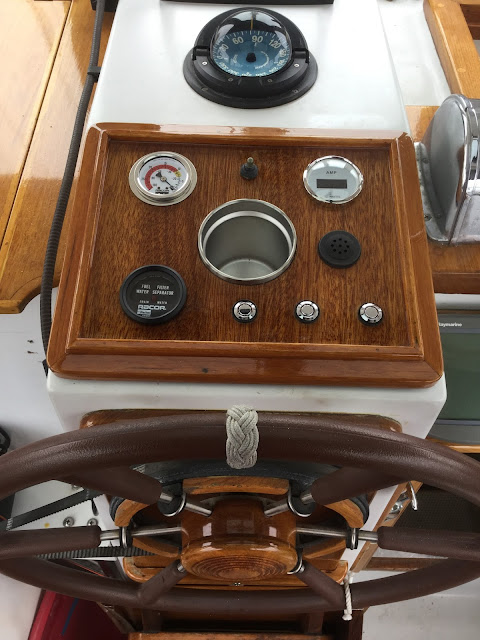Rosalind at her mooring in Galesville, Maryland, USA
Looking forward from the companionway:
Salon to port, galley to starboard, and V-berth forward of the head
We had in our minds what would make the ideal boat for the voyage. The wish list included protection from the elements for the person at the helm, good water and diesel tankage, full standing headroom in the salon and a manageable sail plan. We also wanted the boat to be in the low thirty feet range, or around 15,000 lbs (7 tonnes). Larger and she would be difficult to handle by one of us and shorter she would not have the storage capacity and room to make a comfortable long-term voyager.
Over the years, I have spent countless hours online and in person looking a different boats. To provide some stability, we had developed the 7-day boat buying rule. The rule was simple: no action could be taken until seven days after the decision to buy was made. After having looked at probably thousands of boats online and many others at different marinas in the US and overseas, the Neptunian 33 had eluded us. Maybe it was that only 56 were made, or maybe it had fallen though the cracks of the different searches. After seeing her online, I called the broker and inquired. ROSALIND was in a small marina, tucked in the Rhode River, a stone's throw away from where we have had our previous boat, AISLING, for a dozen years. We arranged a meeting with the broker and went to see ROSALIND. After a thorough walkthrough, we were hooked. An offer was made on the spot. The 7-day rule could not be enforced here!
From the bow going aft (front to back), she has a chain locker (accessible from the fore cabin), a V-berth and a head (W.C. with shower). Across from the head is a sink and vanity. The main cabin has a dinette to port and a galley to starboard. The dinette converts to a double bed and a large companionway connects the main cabin to the cockpit.
Galley to Starboard
Dinette to Port (looking aft)
There's a wheel on centerline at the forward end of the cockpit and a chart table to port. There are cockpit seats with under seat storage (lazarettes) on both sides of the cockpit, and a swinging seat that can be used by the person at the helm if they do not want to stand. The seat is removable and the swinging peristall stores against the forward part of the cockpit, under the chart table, when not in use. The forward half of the cockpit is covered by a hardtop. This hardtop is one of the main features that attracted us to ROSALIND. It provides protection from the elements and a moonroof above the wheel allows the person at the helm to see the main sail and the masthead of the main mast. In addition to the hardtop, there is a removable enclosure with clear plastic sides that can be used to completely close off the cockpit. There is storage throughout the boat, under the berths and outboard in lockers and bins. Water capacity is over 100 US Gallons (400 L) and fuel is about 85 US Gallons (350 L).
Cockpit (looking to starboard) - main cabin companionway with hardtop above
Cockpit (looking to port) - Swivel seat, engine instrument panel, autopilot and chart table
Helm and Alarms Panel
Under the cockpit is the engine room that is accessible through a large hatch. The new engine instruments are to port and the panel from the previous engine has been repurposed and now houses the ships alarms, windlass switch and ampmeter and diesel system monitoring gages.
Engine Room with new Beta 30 Diesel (hot water heater not connected)
ROSALIND is our first center cockpit sailboat and we very quickly saw the multiple benefits of having an aft cabin. The aft cabin has two very nice sea-berths, one on each side, which are only a couple of steps away from the cockpit so the off-watch person can very readily provide assistance if necessary. The aft cabin, being away from the V-berth, offers some privacy for guests. This is not easy to do in 33 ft! Lastly, the aft cabin enabled the designer to create a wonderful aft deck, that together with the two custom stern-rail seats, makes for wonderful seating at anchor or when sailing in fine weather. The other great advantage of the aft deck is that it, together with the swinging swim ladder, makes boarding very easy. When boarding from the dinghy, the large area provides plenty of space to put down bags and groceries. Lastly, the aft cabin has a tool locker to port and a hanging locker to starboard.









No comments:
Post a Comment